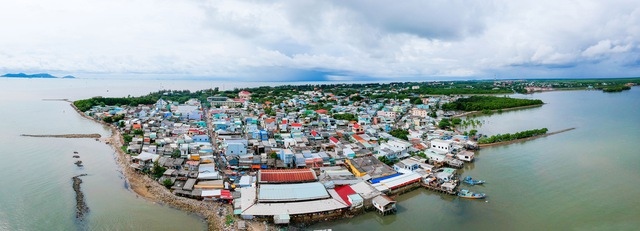After receiving feedback from 10 industries and 3 related provinces, the People’s Committee of Ho Chi Minh City (HCMC) has completed the plan to study and construct the Can Gio International Transshipment Port as directed by the Prime Minister.
The new plan continues to emphasize the development perspective of Can Gio International Transshipment Port as synchronous, modern, applying smart technology, and automation in port management and operation, ensuring effective economic, social, environmental factors, especially for preserving the ecological environment of Can Gio Mangrove Biosphere Reserve.
 Location of Can Gio International Transshipment Port at Con Cho Island, Thanh An Commune, Can Gio District, HCMC. |
The goal of constructing Can Gio International Transshipment Port is to become an international transshipment center of HCMC and the region, attracting shipping lines, carriers, cargo owners, logistics service businesses both domestically and internationally, participating in the global transportation supply chain. The expected capacity by 2030 is 4.8 million TEUs and by 2047 is 16.9 million TEUs.
The construction location is at Con Cho Island, Thanh An Commune, Can Gio District, HCMC.
|
The selection of the project investor, the investor’s capacity will be evaluated by the competent authorities in the project implementation steps according to the law on investment, investor selection, and regulations under Resolution 98/2023 of the National Assembly. |
The scale of container cargo handling up to 250,000 DWT (24,000 TEUs), transshipment vessels with a capacity ranging from 10,000 to 65,000 tons (750 – 5,200 TEUs), and barges with a capacity of up to 8,000 tons (356 TEUs).
The total length of the main port bridge is estimated at about 7 km, and the expected length of the barge wharf is about 2 km. The estimated total area is about 571 ha.
Operating technology: Container handling equipment will use energy-efficient, clean, environmentally friendly energy-powered devices.
Based on the cargo demand through the port, investment is expected to be phased in two stages. The implementation of phase 1 construction and port operation before 2030 (investment in the 2 main berths/7 main berths), phase 2 (after 2030 to 2045) will continue to invest in completing all remaining main berths.
Specifically: Preparatory work from 2023 to 2025; port construction from 2025 to 2027; port operation from 2028.
The People’s Committee of HCMC assesses that when the Port is operational (completion phase), it will directly contribute approximately from 34,000 to 40,000 billion VND per year to the state budget, estimated to create jobs for 6,000 – 8,000 workers.
Regarding the country, the Port will contribute to affirming Vietnam’s position and role on the maritime map as an international transshipment center in the region, attracting major world carriers and logistics service providers, being important links in the global supply chain, making significant contributions to socio-economic development, supporting import-export activities, and reducing intermediaries’ costs.
|
Transportation infrastructure will be invested to serve Can Gio International Transshipment Port. In the period from now to 2030, there will be investment in the construction of Can Gio Bridge to connect from Nha Be District to Can Gio District; investment in the Rung Sac intersection with the Ben Luc – Long Thanh expressway at Binh Khanh Commune; upgrading and expanding existing bridges on Rung Sac Road. Supplementary planning for the urban railway along Rung Sac Road (projected to connect Can Gio coastal urban area with Metro line 4 at Nha Be District); the connecting route between the Can Gio – Cai Mep cluster; the coastal route connecting HCMC (via Can Gio District) with Ba Ria – Vung Tau Province. |
PHAN ANH








































